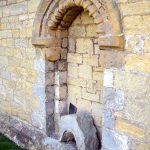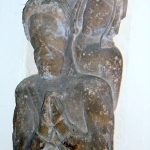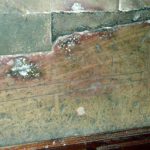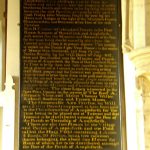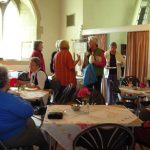Hilda, the Patroness of this church, was Abbess of Whitby in the middle of the 7th century. At that time Whitby was one of the most important Christian centres in England and is famous for the Synod which met there, in St Hilda’s time, in 664.
Foundation of the Church
The church of St Hilda, Ampleforth, was originally one of several chapels dependent on the mother church of St Michael, Coxwold, and passed into the possession of the Augustinian Priory of the Blessed Virgin Mary, Newburgh on its foundation by Roger de Mowbray in 1145. About 1220 Roger, Prior of Newburgh, ceded all rights over the church to Master Godard the Penitentiary, Canon of York and Prebendary of Ampleforth. Thereupon it became a parish church and the Prebendary was Rector of Ampleforth. Because the Rector did not live here a perpetual vicarage was ordained on 28th December 1304. The Prebendary remained the Rector and Patron until such rights were suppressed in 1840, at which time the patronage passed to the Archbishop of York.
Foundation of the Benefice
In 1958, the Vicarage of Ampleforth and the Rectory of Oswaldkirk were united, and the joint patrons were the Archbishop and the Executors of the late Earl of Feversham. The church of the Holy Cross, Gilling East became part of the group soon after;
its Patron is Trinity College, Cambridge. These 3 parishes were joined, some time later by the church of the Holy Trinity, Stonegrave (Stonegrave Minster) to makeup the Benefice as we know it today.
The Church Architecture
The Church was substantially rebuilt in 1868 when the north aisle was added. Only the tower remained untouched.
The font, the fine tower-arch and the north doorway all date from the 12th century. On the arch of the north doorway there are crudely carved signs of the zodiac. The tower in its present form dates from 1474 and was partly rebuilt in 1703.
In the floor towards the west end of the north aisle is a tomb-slab of a priest with a cross and a chalice.
The east end of the church as you see it to-day, was reordered in 1994. There are 3 bells, one of which was first cast in 1623 which has the inscription COME YE CHILDREN AND HEARKEN UNTO ME; a second bell cast in 1637 is inscribed JESUS BE OUR SPEDE. Both were recast in 1894 when a third was added with the inscription REPENT IN TIME.
Grant Aided Work
In the past five years a considerable amount of work, funded by various generous and much appreciated grants, has been carried out.
The west end of the church was re-modelled, removing a number of pews to create a more flexible, open carpeted area, suitable for a number of uses. At this time the font was relocated from the north aisle to the current position in the south west corner, where Baptisms could be conducted more easily.
The second phase saw the cleaning and conservation of the Benefaction Board and the Coat of Arms, generously funded by the Ampleforth Charities and the William and Jane Morris Trust respectively.
The final phase of the major works, financed largely by a grant from LEADER a European funding programme for rural development, saw the installation of a kitchen area at the base of the tower and provision of tables and chairs, to enable refreshments to be served in church. The multi-purpose carpeted area known as St. Hilda’s Meeting Point is well used, and allows hospitality to be offered after services on Sundays and at other times, such as to the children and their parents after St. Hilda’s School harvest festival service. Drop-in coffee mornings and advice surgeries are held once a month throughout the spring and summer, and afternoon teas are served both in and outside church on some summer Sunday afternoons.
This wonderful new facility, has also provided a comfortable space for such fundraising events as a local Antiques Roadshow and choral concerts.

Most recently the clock in the tower has been cleaned and serviced, fitted with an electric winding mechanism and re-gilded, again with funding from the North York moors, coast and hills LEADER small projects programme, in conjunction with Ryedale District Council.


